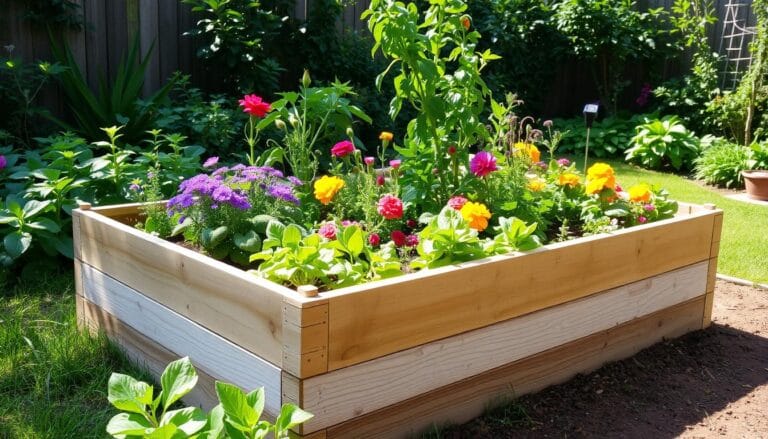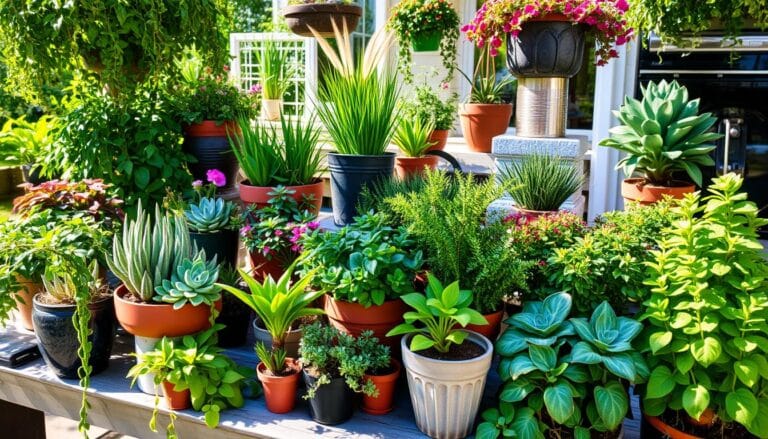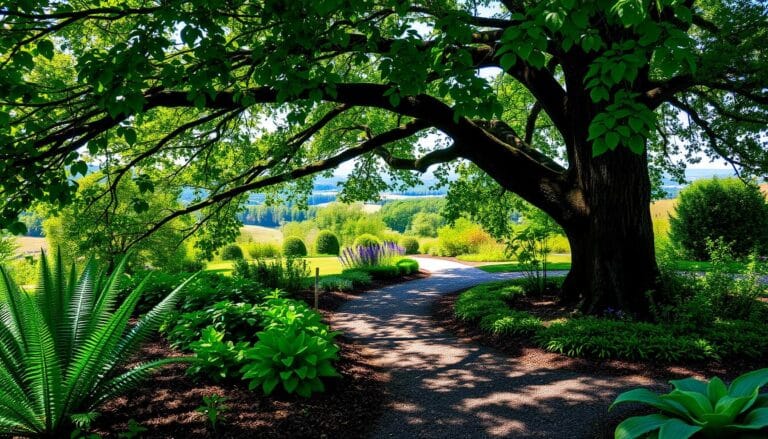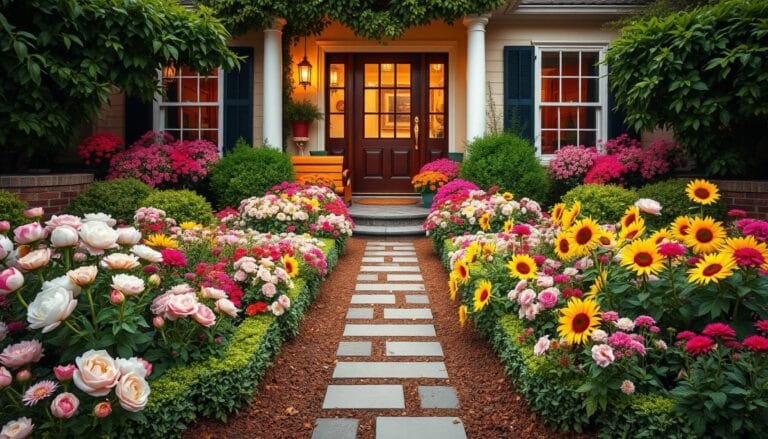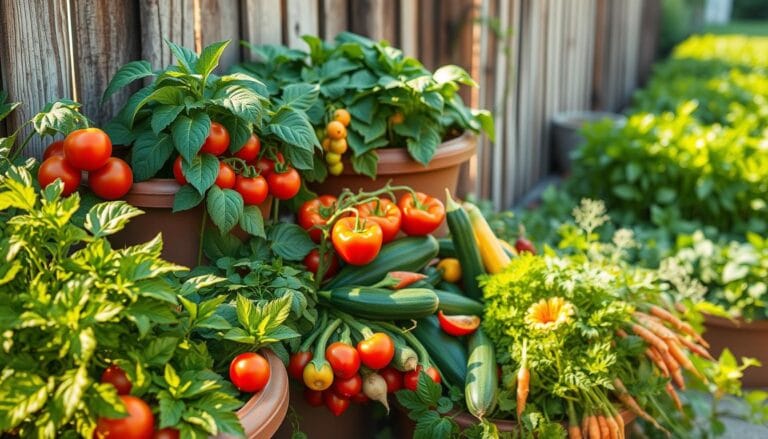How to Set Up Plant Growing Beds for Deck.
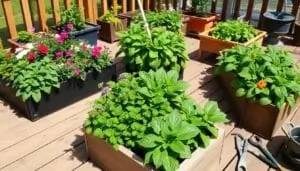
When you step onto your deck, see it as more than just a space. Imagine a lush oasis with greenery and colorful blooms. Turning your deck into a garden might seem hard, but it’s doable. You can make a beautiful spot for plants that will make your outdoor time better.
This guide will show you why deck gardens are great. They let you grow plants longer, control soil better, and use space well. No matter the size of your deck, we’ll share tips for setting up great plant beds. You can grow all sorts of plants, from veggies and herbs to flowers, right outside your door.
Deck gardening is more than the end result. It’s about the journey, the patience, and the joy of watching your plants grow. Let’s start creating your own deck oasis. It’s a place where you can enjoy the beauty and harvest of your hard work.
Table of Contents
Benefits of Installing Growing Beds on Your Deck
Turning your deck into a garden oasis has many perks. Raised growing beds extend your growing season and improve drainage. This makes your plants happy and healthy.
Extended Growing Season and Better Drainage
Deck gardening containers warm up faster in spring and drain better in rain. This means you can grow your favorite vegetable planters for decks longer. You’ll get more harvests.
Space Optimization and Accessibility
Deck gardens use every inch of space. Raised beds make planting, caring, and picking easy. They’re great for anyone who finds gardening hard.
Improved Soil Control and Plant Health
With raised beds, you control the soil. This means better soil for your plants. Your plants will grow stronger and healthier.
“Raised beds are praised for being space-savers, pest deterrents, easily accessible, requiring less weeding, containing high-quality soil, favorable soil temperatures, and better drainage.”
Adding growing beds to your deck opens up a world of gardening benefits. It turns your outdoor space into a lush, productive oasis.
Choosing the Right Location on Your Deck
When planning your deck garden, picking the right spot is key. Look for a place that gets 6-8 hours of sunlight a day. This is best for most plants to grow well. Also, choose a spot close to water for easy watering.
Make sure your deck can hold the weight of the planters. Use vertical space with hanging baskets or rail planters. This way, you can grow more without making your deck look cluttered.
Don’t put plants that attract bees too close to where you sit. This keeps your deck welcoming. Also, think about wind and shade from nearby things.
| Deck Planter Size | Dimensions |
|---|---|
| Small | 30″ L x 16″ W x 15″ H |
| Medium | 40″ L x 20″ W x 15″ H |
| Large | 48″ L x 24″ W x 18.5″ H |
By thinking about these things, you can make a lively and useful deck rail planters or flower bed ideas for decks. It will fit perfectly with your outdoor area.
Essential Materials and Tools for Plant Growing Beds for Deck
Setting up plant growing beds on your deck needs the right materials and tools. You’ll need weather-resistant materials and gardening equipment. These will help make your deck garden project a success.
Construction Materials and Hardware
Choose durable materials like cedar, composite wood, or galvanized steel for your deck planters. These can handle the weather and last long. You’ll also need deck screws, hinges, and brackets to put your beds together securely.
Tools and Safety Equipment
Get the right tools, like a drill, saw, level, and measuring tape. Don’t forget safety glasses and gloves to protect yourself. These tools and safety gear will help you work efficiently and safely.
Soil and Growing Medium Requirements
Use a good potting mix for your deck garden. It should be 50-60% topsoil and 40-50% compost. This mix gives your plants the nutrients and drainage they need. Make sure to calculate the soil needed for your deck beds.
With the right materials, tools, and soil mix, you’re ready to create a beautiful deck garden.
| Material | Quantity | Purpose |
|---|---|---|
| Pressure-treated lumber (2″x8″x8′) | 2 pieces | Framing the raised bed |
| Pressure-treated lumber (2″x8″x10′) | 4 pieces | Framing the raised bed |
| Pressure-treated lumber (2″x4″x12′) | 4 pieces | Supports and bracing |
| Galvanized deck screws (3-inch) | As needed | Assembling the frame |
| Galvanized deck screws (2.5-inch) | As needed | Securing the supports |
“Raised garden beds provide multiple benefits, including improved soil quality, better drainage, increased comfort for gardening tasks, and potentially higher yields due to deeper roots.”
Choose weather-resistant materials, get the right tools, and use a good soil mix. This will help your deck gardening project succeed.
Planning Your Deck Garden Layout
Deck gardening needs a good layout to use space well and look great. Start by thinking about the sun’s patterns on your deck. This helps pick the right plants and where to put them. Group plants by their water and sun needs for best growth.
Use vertical space to save deck area. Raised beds, hanging baskets, and rail planters are great. They help you grow many plants in a small space. Mix different sizes and heights for a lively garden.
Make sure there’s room to move and sit. Use online tools to plan your deck garden. They help you arrange planter boxes for outdoor decks and deck gardening systems well.
- Consider sunlight patterns and group plants with similar needs together
- Incorporate vertical growing options like raised beds, hanging baskets, and rail planters
- Balance container sizes and heights for a visually appealing design
- Allocate space for walkways and seating areas
- Utilize online garden planning tools to visualize and optimize your layout
“The key to a successful deck garden is finding the right balance between practical considerations and aesthetic appeal.”
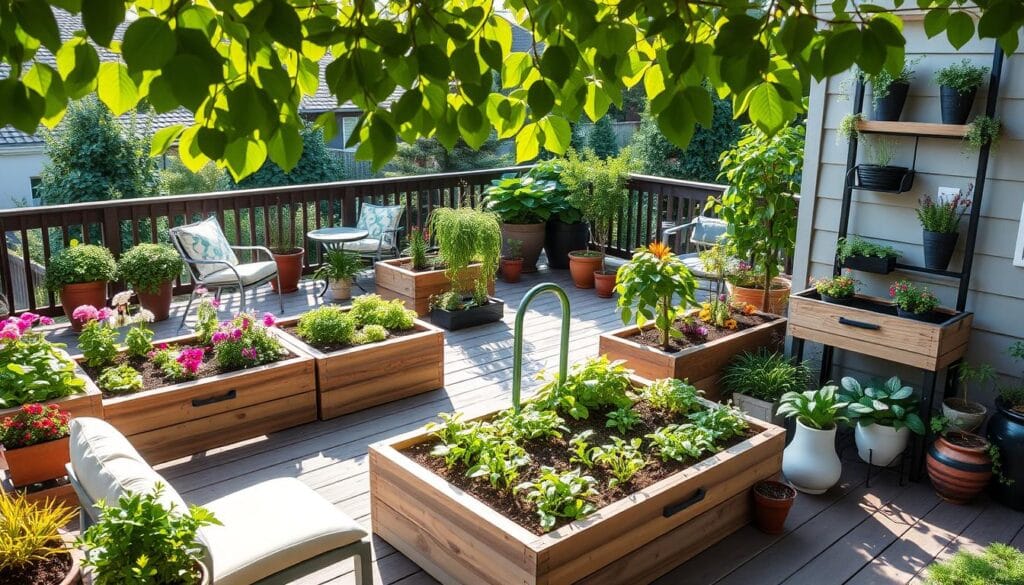
Plan your deck garden well to make a lush oasis. It will give you plenty of fresh produce and make your outdoor space better.
Building and Installing Deck Planter Boxes
Creating raised garden beds for your deck is a great way to grow a garden in a small space. You can either build them yourself or buy pre-made ones. Here’s a simple guide to help you set up your deck planter boxes.
Step-by-Step Assembly Guide
Start by measuring the space on your deck. This will help you figure out the right size for your planters. Use the instructions or DIY plans to build the frames with pressure-treated or rot-resistant wood. Add landscape fabric at the bottom to stop soil from falling out.
Proper Installation and Securing Methods
After building the planters, make sure they’re level and securely attached to your deck. This keeps them from moving or tipping over when you add soil and plants. Use galvanized spikes, deck screws, or other hardware to fix them to the deck.
Drainage System Setup
Drainage is key for your plants’ health. Drill holes in the bottom of the planters and place them slightly off the ground. This lets air flow under and prevents water damage to your deck.
By following these steps, you can easily create a lively and productive deck garden. Raised beds and deck-friendly planters help you use your space well. You’ll enjoy a lush, thriving garden right on your deck.
Selecting the Best Soil Mix and Amendments
Choosing the right soil mix is key for a thriving deck garden. The soil supports plant health, ensures good drainage, and provides nutrients. Start with a well-draining potting mix made for container gardens. This mix helps with aeration and keeps moisture right for plants in raised beds or planters.
Adding organic matter like compost can boost soil quality. Compost improves soil structure, adds nutrients, and helps hold water better. Perlite or vermiculite can also be added to improve drainage and aeration, stopping water from pooling.
| Soil Amendment | Benefits |
|---|---|
| Compost | Improves soil structure, increases nutrient content, and enhances water-holding capacity. |
| Perlite | Enhances drainage and aeration, preventing waterlogging. |
| Vermiculite | Improves drainage and aeration, while also retaining moisture for plant roots. |
Slow-release fertilizers can also be used to feed your plants over time. This way, your plant growing beds for deck and vegetable planters for decks will grow well without needing constant fertilizing.
Remember to check the soil pH and adjust it if needed. This ensures your plants get the best conditions to grow and produce well.
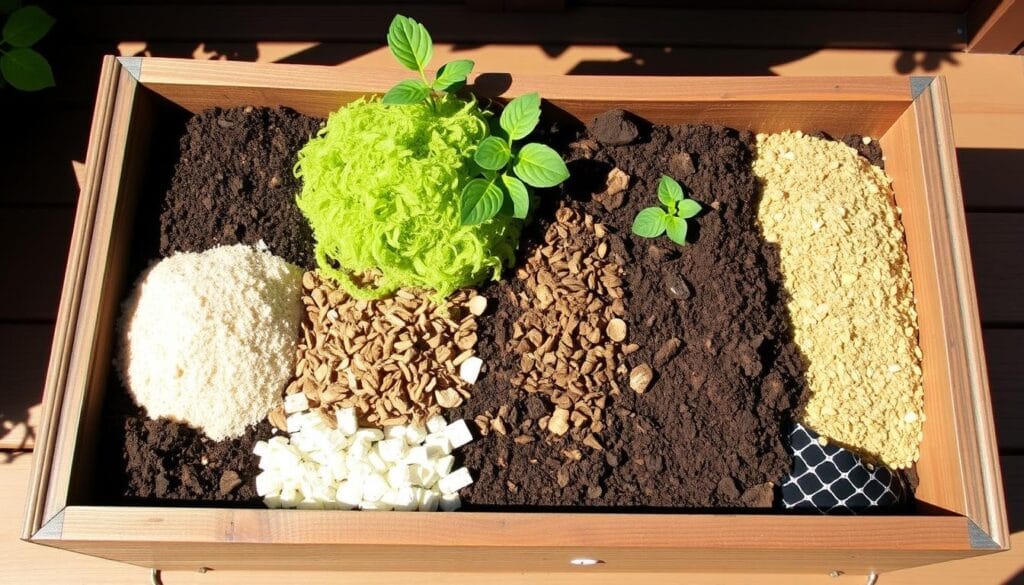
“The right soil mix is the foundation for a successful deck garden. It’s worth taking the time to get it right.”
Choosing Plants for Your Deck Garden
Choosing the right plants is key to a thriving deck garden. You can turn your deck into a lush oasis with the right picks. Let’s look at the best plants for your deck garden containers and flower beds.
Vegetables Suitable for Deck Growing
Grow your own food with compact or dwarf vegetables on your deck. Cherry tomatoes, peppers, and leafy greens like lettuce and kale do well in containers. They let you enjoy a big harvest even in small spaces.
Herbs and Flowers for Container Gardens
Deck gardens are great for growing herbs and flowers. Herbs like basil, mint, and thyme add flavor and beauty. For a colorful display, try marigolds, petunias, and geraniums, which love container gardens.
Companion Planting Strategies
Companion planting boosts your deck garden’s health. It improves soil, keeps pests away, and creates a balanced ecosystem. For example, basil with tomatoes or marigolds around veggies can keep bugs off.
Think about size, sunlight, and care when picking plants for your deck. The right plants turn your outdoor space into a lively oasis that shows off your style and gardening love.
| Plant Type | Best Varieties for Deck Gardening | Key Considerations |
|---|---|---|
| Vegetables | Cherry tomatoes, peppers, leafy greens | Compact or dwarf varieties, container-friendly |
| Herbs | Basil, mint, thyme | Easy-to-grow, provide flavor and fragrance |
| Flowers | Marigolds, petunias, geraniums | Thrive in containers, add visual interest |
By picking the right plants, you can make your deck garden vibrant and useful. It will show off your style and love for gardening.
Maintenance and Care Tips
Keeping your elevated garden beds on your deck healthy is key. You need to water them often, use the right fertilizer, and watch out for pests. These steps will help your elevated garden beds for decks and deck gardening systems grow well all season.
Consistent Watering
Water your garden beds often, checking the soil every day. This is especially important when it’s hot. Raised beds hold more water, but they still need regular watering to keep plants healthy.
Fertilizing for Optimal Growth
Use liquid or slow-release fertilizers for your deck garden. This gives your plants the nutrients they need to grow well in their space.
Pruning and Harvesting
Prune and harvest your plants often. This helps them grow and produce more. Keeping up with these tasks will make your elevated garden beds for decks look good and your deck gardening systems productive.
Pest and Disease Management
Check your garden often for pests or diseases. Use organic methods to fix any problems. This keeps your plants healthy and strong.
Mulching for Moisture Retention
Put organic mulch on your garden beds. It keeps the soil moist and the right temperature. This means you won’t have to water as much and your plants will grow better.
Providing Plant Support
Use trellises or cages for tall plants in your deck gardening systems. This helps them grow without taking over the planter.
By following these tips, your elevated garden beds for decks and deck gardening systems will give you a great harvest all season.
| Maintenance Task | Frequency | Purpose |
|---|---|---|
| Water | Daily during hot weather | Maintain soil moisture for plant health |
| Fertilize | Monthly | Provide essential nutrients for growth |
| Prune and Harvest | As needed | Encourage continued production |
| Pest and Disease Monitoring | Weekly | Identify and address issues promptly |
| Apply Mulch | Annually | Retain soil moisture and regulate temperature |
| Provide Plant Support | As needed | Ensure proper growth and production |
Conclusion
Setting up plant growing beds on your deck is rewarding and practical. It lets you grow a garden in a small outdoor space. EZBlocks wooden blocks make it easy to create customized raised beds that look great and help your plants grow better.
Deck gardens offer many benefits. They let you grow fresh veggies, herbs, and flowers. You get longer growing seasons, better drainage, and healthier plants.
When planning your deck garden, think about the best spot, the right tools, and the perfect plants. Follow good practices for soil, installation, and care. This way, you’ll get a lot of harvest and a beautiful outdoor space.
With this article’s help, you’re ready to start a successful deck garden with EZBlocks. Try out different layouts and plants to make your garden unique. Enjoy growing your own food and being surrounded by nature in your outdoor retreat.
FAQ
What are the benefits of installing growing beds on my deck?
How do I choose the right location on my deck for plant growing beds?
What materials and tools do I need to build plant growing beds for my deck?
How do I plan the layout of my deck garden?
What are the steps for building and installing the plant growing beds on my deck?
What type of soil mix should I use for my deck garden?
What plants work best for a deck garden?
How do I maintain my deck garden?
Source Links
- Want to Plant a Garden on Your Deck? Here Are 12 Tips to Help It Flourish – https://www.thespruce.com/planting-on-a-deck-tips-8549861
- How to Build a Raised Garden Bed for Under $50 – https://www.almanac.com/content/how-to-build-a-raised-garden-bed
- Build your own DIY raised garden beds – https://hanashappyhome.com/diy/wood-working/build-your-own-diy-raised-garden-beds/
- Raised Beds vs. In Ground—Which is Better for Gardening? – Garden Therapy – https://gardentherapy.ca/raised-beds-vs-in-ground/
- Pros and Cons: Row Gardening vs. Raised Beds vs. Containers – https://www.almanac.com/gardening-methods-overview
- Vegetable and Flower Raised Garden Bed Ideas for Cedar Planters – https://pergoladepot.com/cedar-planter-plant-pairings/?srsltid=AfmBOooGuuegx1FTOQBP53VrN7vp0OM4rc8vyjcHlSP_9WssHCC7cxsb
- Raised Garden Bed Ideas for Your Spring Planting – https://sowtrueseed.com/blogs/gardening/raised-garden-bed-ideas-for-your-spring-planting?srsltid=AfmBOop0f2Dxc-QwnV_kNnC020FSXrTHhaWZMJW2dBAF9FeCNAK_6KEA
- How to Build Raised Garden Beds | Thunderbird Disco Homestead – Permaculture Homesteading Blog – https://www.thunderbirddisco.com/blog/how-to-build-raised-garden-beds
- Raised Garden Beds Buying Guide – https://www.homedepot.com/c/ab/raised-garden-beds-buying-guide/9ba683603be9fa5395fab9015241c551
- Guide to Raised Beds: Plans, Timing, Tending | Gardener’s Supply – https://www.gardeners.com/how-to/raised-bed-basics/8565.html?srsltid=AfmBOorpEOhBSmMY_GsMFDM4pqILeWFbi4Buavi6rx_yQdwrAuhN4ahj
- 12 Raised Garden Bed Plans for Building Your Ideal Plot – https://www.bobvila.com/articles/raised-garden-bed-plans/
- How to Plan a Vegetable Garden Layout Step-by-Step – https://www.epicgardening.com/vegetable-garden-layout/
- Wood DIY Deck Planter Box to Upgrade an Old Deck with Plants and Style – https://www.frugalfamilytimes.com/2021/09/diy-wood-planter-to-upgrade-an-old-deck-with-plants-and-style/
- Brite Decking | Build a Composite Garden Bed In 7 Steps – https://www.britedecking.com.au/build-composite-board-garden-bed/
- Guide to Raised Beds: Plans, Timing, Tending | Gardener’s Supply – https://www.gardeners.com/how-to/raised-bed-basics/8565.html?srsltid=AfmBOoqoqmzQQG8-tn9TK4-Ok2oJ_3V60O49o_7Y4kvIjRlxdi2boyq-
- Choosing the best potting soil for healthy indoor and outdoor plants – https://growcycle.com/learn/choosing-the-best-potting-soil-for-healthy-indoor-and-outdoor-plants?srsltid=AfmBOoqHrus8BLEOjcwQqxAIWAwG5ejAeKOBJ0Ckq-K_knKN-Sczy48g
- Best Plants for Deck Planters: 8 Stunning Picks for Homeowners – https://potsplantersandmore.com/blog/best-plants-for-deck-planters?srsltid=AfmBOorF-xHneLRop8Av4Qdx0r1d9OA5tMb76CrnEoukuY0zzGMsNIyZ
- Our Top 55 Container Gardening Ideas Will Bring So Much Charm to Your Porch or Patio – https://www.countryliving.com/gardening/garden-ideas/g4098/best-plants-for-container-gardening/
- Guide to Raised Beds: Plans, Timing, Tending | Gardener’s Supply – https://www.gardeners.com/how-to/raised-bed-basics/8565.html?srsltid=AfmBOooFifQ558S0efks3K7NBge3-W1e2_QYSZDESafIV14jXazPa9-3
- How To Maintain a Simple Vegetable Garden? – https://www.dripworks.com/bloghow-to-maintain-a-simple-vegetable-garden/?srsltid=AfmBOopp68kUDIIszLT6gPIMAqF1lM_aoC3-FY1nfVl8PnAB5T4580Kr
- EZblocks DIY Raised Garden Beds and Planters – EZblocks – https://www.ezblocks.ca/news-diy-raised-garden-beds/
- 4 Fantastic Deck Planter Ideas | Master Any Outdoor Living Space With Deck Planters! – https://jbdconcepts.com/blogs/guides/deck-planter-ideas?srsltid=AfmBOoriqlhXG5BxAVXMlkAxc-ud_aelS_fOD6600-zA53p9vODy1ym_
There are no reviews yet. Be the first one to write one.

